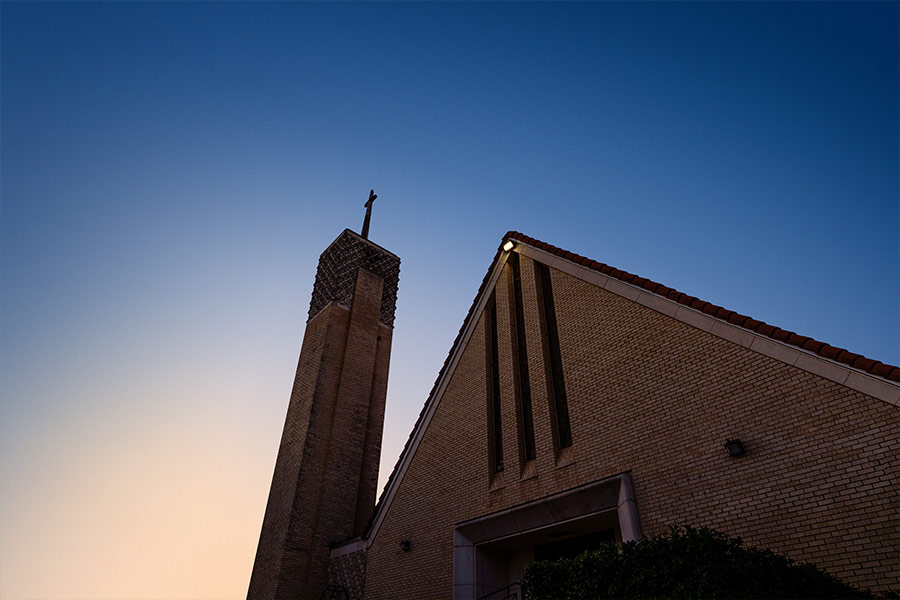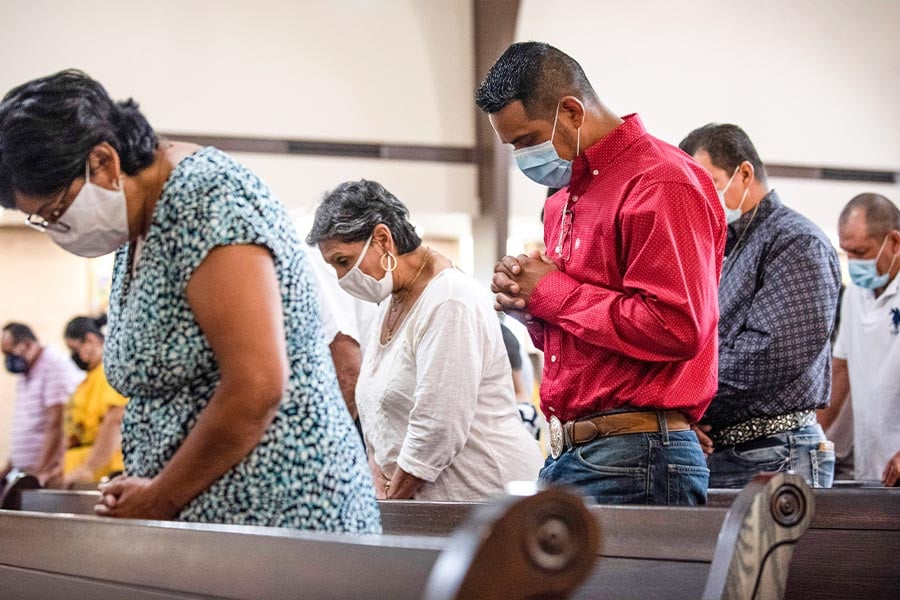Hispanic-Latino roots run deep within the Diocese of Fort Worth: Part 3

All Saints Church (NTC/Juan Guajardo)
Responding to growing Hispanic population
By 1925, Bishop Lynch said the challenge of keeping up with the growing number of Hispanic Catholics “became pressing.”
The bishop wrote, “To alleviate the condition, I made a trip to Madrid [Spain] … for the sole purpose of interesting the General of the Claretians to send additional missionaries.”
Bishop Lynch was successful in his bid, as a long line of Claretian priests subsequently came to serve the growing Hispanic population in North Texas.
In 1955, Diocese of Dallas-Fort Worth Bishop Thomas K. Gorman trusted the missionaries to care for All Saints Catholic Parish on the Northside of Fort Worth, during its merger with San Jose Catholic Church. The San Jose Church had been established in 1909 within the boundaries of All Saints to serve the needs of Spanish-speaking Catholics in the area. With the 1955 unification of a strongly Hispanic San Jose and the traditionally Anglo All Saints, the new church, which kept the name All Saints, became a bilingual, bicultural parish. The missionaries also enlisted the help of the Guadalupan Catechist Sisters to open and administer catechism centers in the parish and throughout Fort Worth.
Fourteen years after the bicultural parish took root, the Diocese of Fort Worth was established in 1969. Its first shepherd, Bishop John J. Cassata, was trusted not only with administration of a new diocese, but also with carrying out many changes in the Church as a result of the Second Vatican Council. One of those changes involved celebrating Catholic Mass in the familiar language of the faithful.
Bishop Cassata stressed that the shift from celebrating Mass in Latin to the vernacular of the local faithful “gives people a more intimate part in the Liturgy. And this is important if we are to come to an intimacy with Christ.”
One of bishop’s most important and far-reaching acts as shepherd involved his strong encouragement for seminarians to learn the Spanish language and to develop a deeper understanding of the Mexican-American culture. A forward looking leader, Bishop Cassata knew this would go a long way toward strengthening Christ’s Church in North Texas and its rapidly growing Catholic population.
Following Bishop Cassata’s retirement in 1980, the welcomed challenge of reaching out to an ever-expanding Catholic population in the Diocese of Fort Worth has been met by subsequent bishops, including Bishop Michael F. Olson.
Dynamic Catholic Hispanic population and ministry today
Today, as the Diocese of Fort Worth surpasses 1 million Catholics, it has become one of the fastest growing dioceses in the nation. The Hispanic population, by far, is increasing at a greater rate than any other cultural group, according to statistics prepared for V National Encuentro of Hispanic/Latino Ministry.

Parishioners bow their heads for prayer during a Special Mass welcoming Deacon Bradley Samuelson to Our Lady of Guadalupe Parish in Wichita Falls, Aug. 30, 2020. NTC/Ben Torres)
V National Encuentro involved a gathering in 2018 of 3,000 Hispanic leaders from dioceses, schools, universities, and other Catholic organizations across the nation. It was the fifth such gathering since 1972 and was held in Grapevine, in the Diocese of Fort Worth. Its purpose has been to determine how the Church can best minister to Hispanics and how they, in turn, can better engage with the Church.
Based on V Encuentro’s statistics from the year 2016, the Catholic population in the Diocese of Fort Worth stood at 762,000 people. Of those, 450,000 (51 percent) were Hispanic.
Additionally, this most recent study showed that of the 90 parishes (at the time) in the Diocese of Fort Worth, 46 have maintained an organized Hispanic ministry.
One of those many parishes is Our Lady of Guadalupe in Wichita Falls. For the past 25 years, the parish has benefited from the tireless work of Anastasio Perez, who became its bilingual permanent deacon after his retirement as a welder.
“Deacon Perez was the very first deacon assigned to Our Lady of Guadalupe,” said Maria Kalbfliesh, the church’s pastoral assistant. “He has been assisting our priests with Baptisms, funerals, marriage preparation, bilingual Masses, and wherever he is needed. The people here just love Deacon Perez.
“As many people know, our priests are always very busy, and for a parish to have a deacon who speaks both languages, English and Spanish, is wonderful,” Kalbfliesh said.
“Our priest needed help and that’s what really motivated me to become a permanent deacon,” a humble, 89-year-old Dcn. Perez said. “I thought I really needed to do something to help. I have enjoyed doing everything. I just enjoy serving people. That’s what a deacon is, a server. I’ll keep doing it as long as I can.”
With 700 member families and more than 1,000 faithful regularly attending weekly Masses in both English and Spanish, Our Lady of Guadalupe has experienced rapid growth during its 93 years of existence.
Not only has the bilingual church grown from an increasing number of Catholics residing inside its parish boundaries, but from the faithful living in the greater area as well.
“We have Catholics not only from Wichita County attending Masses, but also from surrounding counties as well,” Kalbfliesh explained. “They come to attend Mass that is celebrated in their language.”
To keep up with the parish’s growth, its pastoral assistant said that Our Lady of Guadalupe Pastor Raul Martinez Lopez has been busy with myriad tasks, including recent church renovations.
“And now our church has been blessed with another bilingual deacon,” Kalbfliesh said. Joining Dcn. Perez is a new permanent deacon, Bradley Samuelson.

Deacon Bradley Samuelson waves to parishioners as they welcome the new deacon with a social distance car parade after Sunday Mass, at Our Lady of Guadalupe Parish in Wichita Falls, Aug. 30, 2020. (NTC/Ben Torres)
Ordained by Bishop Michael F. Olson on August 10, 2020, for the Diocese of Fort Worth, Dcn. Samuelson said he left his private practice as a cardiologist to more fully serve Christ’s Church.
The deacon earned two Doctor of Medicine (M.D.) degrees — one from the United States and one from Colombia — and maintained a private practice in cardiology in Wichita Falls for more than 25 years before answering God’s new calling for him.
Dcn. Samuelson said the Lord truly has worked in mysterious ways during his life. A decision to visit Colombia as an undergraduate college student ultimately led Dcn. Samuelson to his mission as a Catholic deacon.
The son of a Lutheran minister, the young college student enjoyed his stay in Colombia so much that he later decided to study medicine there and stay for nine years. During his many years of living in Colombia, Dcn. Samuelson met his wife who, he said, led by example as a Catholic and helped him discover the rich spiritual teachings of Catholicism. He was welcomed into the Catholic Church in 2001.
Through the years, the doctor’s family, as well his faith, continued to grow. With his wife and family, the man who now serves the diocese as a permanent deacon has worked as a missionary in Haiti for the past 24 years and in Guatemala for the past 10 years.
In addition to his service as a deacon to the bilingual community at Our Lady of Guadalupe, Dcn. Samuelson said, “Missionary work is my heart and soul, too.”
Time spent in Colombia, immersion into the Spanish language and Hispanic culture, marriage to a devout Catholic, and a family engaged in mission ministry all led the cardiologist to his new ministry.
“When I look back and see the Lord’s work in preparing me for this ministry, at this particular time, it is mind blowing. How I was called to be here at this point in order to do this ministry, in this exact way, is just amazing to me,” Dcn. Samuelson said.
The new deacon said his work as a cardiologist and his present duties as a permanent deacon have their similarities and differences.
“They are similar because of the quantity of work you have to dedicate to each job,” Dcn. Samuelson said. “What is different is that in cardiology work, you are interested in ‘doing’ — doing something to make people better. As a deacon it is all about ‘being’ — being there to provide people with the support they need.”
